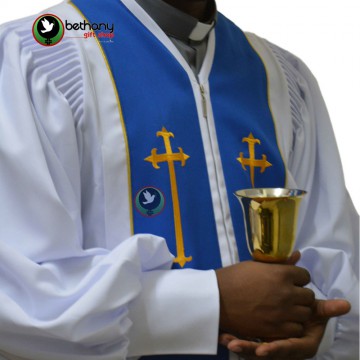Colors and meanings applied on Clerical Clothings

25/08/2020 / By Pastor Moses Mwicigi
Colors
Since fabrics, such as banners and vestments, have to be some color or the other, the historic Church has taken advantage of this fact and has used color to set the theme of worship. Color usage was less diverse in the past, mainly because dyes were expensive and it wasn’t as easy as it is today to get fabric in any color.
In modern times, we’ve developed a consensus about the use of colors in the western Church. green, purple, white, and red, with gold or ivory being alternatives to white. Protestant churches sometimes use blue. Black is, for the most part, no longer in use. This information is valid only for western Churches. Orthodox Churches use colors differently.
Green
[Standard] Green is the default color. Green is the color of vegetation, therefore it is the color of life. Green is the color for the Season after the Epiphany and the Season After Pentecost. These two seasons are also called Ordinary Time
because the Sundays have no names, just ordinal numbers.
Purple
[Standard] In antiquity, purple dye was very expensive. Lydia in Acts 16:14 was a businesswoman who dealt in purple, so she must have been the first-century equivalent of a millionaire. Since purple was so expensive, and since only wealthy people could afford it, it came to signify wealth, power, and royalty, much like caviar does today. Therefore purple is the color for the seasons of Advent and Lent, which celebrate the coming of the King. Since as Christians we prepare for our King through reflection and repentance, purple has also become a penitential color.
White
[Standard] Angels announced Jesus’ birth (Luke 2:8-15) and His Resurrection (Luke 24:1-8). The New Testament consistently uses white to describe angels and the risen Lord (see Matthew 17:2 and 28:3, Mark 9:3 and 16:5, John 20:12, Acts 1:10, and throughout Revelation.) In the ancient Church, people were given white tunics (albs) as soon as they emerged from the waters of baptism. Therefore, white is the color for the seasons of Easter and Christmas. White is the color for funerals, since it is the color of the Resurrection, for weddings, regardless of the season, and for secular holidays that are observed in the church.
Gold
[Standard alternative or addition] Gold can be an alternative or addition to white or ivory.
Ivory
[Standard alternative or addition] Ivory can be an alternative or addition to white or gold.
Red
[Standard] Red is the color of blood, and therefore also of martyrdom. Red is the color for any service that commemorates the death of a martyr. It is also an alternative color for the last week of Lent, which is called Holy Week. Red is the color for Pentecost Sunday and for ordinations and installations, because it is the color of fire and therefore also of the Holy Spirit (see Acts 2:3).
Indigo
[Lutherans Only] According to the Manual on the Liturgy, Lutheran Book of Worship (Augsburg, 1979), on page 22, the traditional color for Advent is purple,
but the preferred color in the Lutheran Book of Worship, however, is blue, which has a precedent in the Swedish Church and in the Mozarabic rite. Blue suggests hope, a primary theme of Advent.
I’m calling it blue, but it is actually a shade of blue called indigo. Indigo is the color of the sky right before sunrise, therefore the color of hope.
Blue
[Catholics, maybe] In Orthodoxy and Catholicism, blue represents the Virgin Mary, because she is known as the Queen of Heaven, and because the sky (the heavens) is blue. Orthodox icons of Mary generally have a blue background. Blue paraments and vestments are not authorized for use in the Catholic Church, except in some isolated areas that have special permission to use them.
Black
[Standard only for clericals] Black is the color of clericals. (Cassocks are clericals, not vestments.)
Before the advent of modern dyes, all dress clothes were black—just look at any photograph taken in the 19th century. The main historical connotation of black is formality. Because we don’t wear black as often today, it has survived as a formal color only at extremely solemn occasions, such as funerals. For some people today, black immediately connotes a funeral. Black is sometimes, but rarely, the color for funeral services, Good Friday, and All Souls Day (2 November).
Rose
[Optional] Rose (that is, a shade of pink) was sometimes used on the third Sunday in Advent, to signify joy.
The use of the color rose has a strange origin. Long ago, the pope had the custom of giving someone a rose on the fourth Sunday in Lent. This led the Roman Catholic clergy to wear rose-colored vestments on that Sunday. The effect was to give some relief the solemnity of Lent, so this was a very popular custom. Originally—before shopping malls—Advent was a solemn fast in preparation for Christmas, so the custom was extended to the third Sunday in Advent to liven it up a little bit, too. Somewhere in there the third candle of the Advent wreath turned pink. Meanwhile, Advent is no longer solemn and the pope no longer has the custom of giving out roses. It is kind of odd to think that a Methodist would put a pink candle in a Lutheran Advent wreath because the pope used to have the custom of giving out roses, but sometimes we’re a little more ecumenical than we realize!
In the Catholic Church, rose is an alternative color for the fourth Sunday in Lent (Laetare Sunday) and the third Sunday of Advent (Gaudete Sunday).
Borrowed from https://www.kencollins.com/glossary/liturgy.htm#colors




